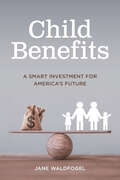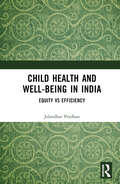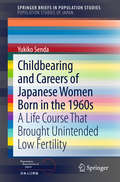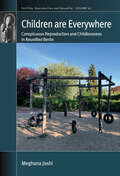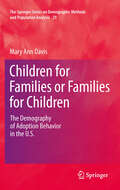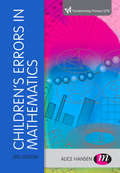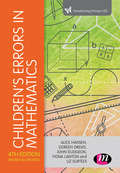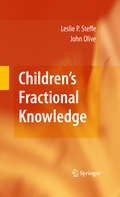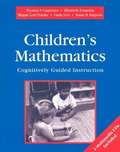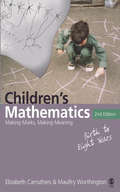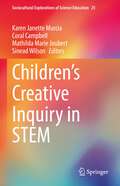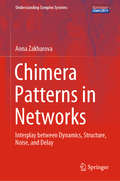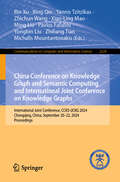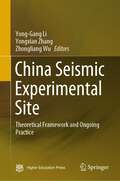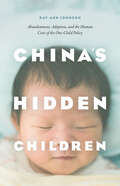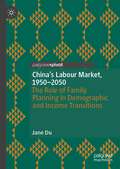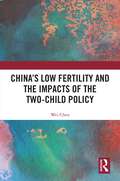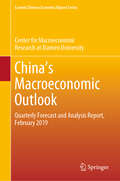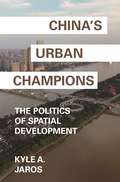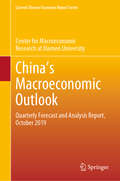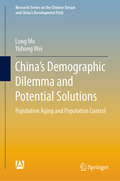- Table View
- List View
Child Benefits: The Smart Investment for America's Future
by Jane WaldfogelThe United States has one of the highest child poverty rates among wealthy countries and stands out among its peers as the only country that does not offer a child benefit – regular payments from the government to most or all families with children, not conditioned on parental employment. During the temporary expansion of the Child Tax Credit (CTC) in 2021, the CTC functioned as a child benefit, and the child poverty rate fell to the lowest level ever recorded in the United States. Despite this decrease, the CTC expansion was not renewed. Concerns about enacting a child benefit include the cost, the possibility of misuse of money by parents, and how it might affect parental employment and fertility. In Child Benefits, social policy scholar Jane Waldfogel details the history and origins of child benefits around the world and comprehensively assesses how child benefits affect family spending, fertility, employment, child poverty, and child wellbeing to address such concerns and to determine the benefits of enacting such a policy permanently. Drawing on research from peer countries in the Organization for Economic Cooperation and Development as well as the United States, Waldfogel shows that a child benefit would prevent poverty and hardship and protect children from deep poverty and income instability. The research is clear that families would spend the money from a child benefit on food, clothing, and other items for their children and that a child benefit would not have large negative impacts on parental employment or family decisions about fertility. It also shows that a child benefit would promote short- and longer-term child and family wellbeing. Child benefits have been shown to enhance opportunity and benefit society through healthier and better-educated young adults and stronger and more stable families. And rigorous benefit-cost analyses indicate that a child benefit, while costly, would more than pay for itself, yielding a large return on investment. Waldfogel evaluates four current, major proposals for a child benefit and provides recommendations for a policy that would deliver the best outcomes for children and families and the best return on investment. She argues that such a policy would be more generous, not tied to parental employment or earnings, available to all parents but phased out for higher-income families, delivered in monthly payments through the tax system, and provided in addition to existing social programs. Child Benefits provides fascinating insights on the history and impacts of child benefits and makes a clear and definitive argument for the establishment of a child benefit in the United States.
Child Health and Well-being in India: Equity vs Efficiency
by Jalandhar PradhanThis book examines the state of child health and well-being in India. It traces the roots of child health inequalities in India; draws on the latest NFHS-V, 2019–21 data; and analyses various child health and nutrition indicators from the perspective of equity and efficiency. This volume addresses various contexts and methodologies available to measure health inequalities among Indian children. It also assesses the child’s well-being in terms of “Multidimensional Child Poverty”. As a policy document, this work examines and quantifies the equity and efficiency dimensions of various child health indicators among Indian states. Assessment of between- and within-group inequalities by various socio-economic groups provides new insights into addressing the issue of health inequalities among Indian children. An in-depth work on child health and development, this book will be of great interest to scholars and researchers of health and public policy, development studies, health economics, and South Asian studies. It will also be of use to NGOs, policymakers, and think-tanks in the field.
Childbearing and Careers of Japanese Women Born in the 1960s: A Life Course That Brought Unintended Low Fertility (SpringerBriefs in Population Studies)
by Yukiko SendaThis book provides the keys to understanding the trajectory that Japanese society has followed toward its lowest-low fertility since the 1980s. The characteristics of the life course of women born in the 1960s, who were the first cohort to enter that trajectory, are explored by using both qualitative and quantitative data analyses. Among the many books explaining the decline in fertility, this book is unique in four ways. First, it describes in detail the reality of factors concerning the fertility decline in Japan. Second, the book uses both qualitative and quantitative methods to introduce the whole picture of how the low-fertility trend began in the 1980s and developed in the 1990s and thereafter. Third, the focus is on a specific birth cohort because their experiences determined the current patterns of family formation such as late marriage and postponed childbirth. Fourth, the book explores the knife-edge balance between work and family conditions, especially with regard to childbearing, in the context of Japanese management and gender norms. After examining the characteristics of demographic and socioeconomic circumstances of postwar Japan in detail, it can be seen that the change in family formation first occurred drastically in the 1960s cohort. Using both qualitative interview data cumulatively from 150 people and quantitative estimates with official statistics, this book shows how individual-level choices to balance work and family obligations resulted in a national-level fertility decline. Another focus of this book is the increasing unintended infertility due to postponed pregnancy, a phenomenon that is attracting great social attention because the average age of pregnancy is approaching the biological limit. This book is a valuable resource for researchers who are interested in the rapid fertility decline as well as the work-life balance and the life course of women in Japanese employment practice and family traditions.
Children are Everywhere: Conspicuous Reproduction and Childlessness in Reunified Berlin (Fertility, Reproduction and Sexuality: Social and Cultural Perspectives #53)
by Meghana JoshiChildren are Everywhere engages with how demographic anxieties and reproductive regimes emerge as forms of social inclusion and exclusion in a low fertility Western European context. This book explores everyday experiences of parenting and childlessness of ‘ethnic’ Germans in Berlin, who came of age around the fall of the Berlin Wall, and brings them into conversation with theories on parenting, waithood, non-biological intimacies, and masculinities. This is the first ethnographic work by a South Asian author on demographic anxieties and reproduction in Germany and reverses the anthropological gaze to study Europe as the ‘Other.’
Children for Families or Families for Children: The Demography of Adoption Behavior in the U.S. (The Springer Series on Demographic Methods and Population Analysis #29)
by Mary Ann DavisDo adoptions provide children for families or families for children? This book analyzes the complex interactions between adopters and adoptees using historical and current data. Who are the preferred parents and children, both domestically and internationally? How do the types of adoptions-domestic adoptions, private and public through the foster care system, and intercountry adoptions-differ? Domestic trends include a shift to open adoptions and a notable increase in "hard to place", foster care adoptions-typically older, siblings, minorities, with physical, educational, or emotional challenges. Adoptive parents are increasingly all ages (including grandparents); all types of marriages (single, married and same-sex couples); all income levels, with subsidized adoptions for children who would otherwise remain in foster or institutional care. Intercountry adoptions have followed waves, pushed by wars and political or economic crises in the sending country, and pulled by the increasing demand from the U. S. Currently there is a decrease in intercountry adoptions from Asia and Eastern Europe with a possible fifth wave from Africa with the greatest number from Ethiopia. This is a resource for family sociologists, demographers, social workers, advocates for children and adoptive parents, as well as those who are interested in the continuing research in adoptions.
Children's Errors in Mathematics
by Alice HansenThis practical guide to children’s common errors and misconceptions in mathematics is ideal for primary trainees, helping them gain a deeper understanding of the difficulties encountered in mathematical development. This second edition has been fully revised and all links to the EYFS and the Revised Primary Framework have been updated. New research and literature are included, additional errors are considered, and Using and Applying Mathematics is fully embedded throughout. Individual misconceptions are dealt with and in each case a description and explanation of the error is provided. The teacher's role in understanding and addressing common misconceptions is also covered.
Children's Errors in Mathematics
by Alice Hansen John Dudgeon Doreen Drews Liz Surtees Fiona LawtonThis practical guide to children's common errors and misconceptions in mathematics is a popular planning tool for primary trainees. It supports a deeper understanding of the difficulties encountered in mathematical development. This third edition has been updated to link to the new National Curriculum. New for this edition is a chapter on addressing errors misconceptions which explores how errors can best be identified and countered. The text examines misconceptions individually and in each case provides a description of the error alongside an explanation of why the error happens. The text also considers the role of the teacher in understanding and addressing children's common mathematical misconceptions.
Children's Errors in Mathematics: Understanding Common Misconceptions In Primary Schools (Transforming Primary QTS Series)
by Alice Hansen John Dudgeon Doreen Drews Liz Surtees Fiona LawtonThis practical and popular guide to children’s common errors and misconceptions in primary mathematics is an essential tool for teachers and trainees. It supports them in planning for and tackling potential errors and enhances their understanding of the difficulties encountered in mathematical development. This fourth edition explores how a Growth Mindset approach works alongside an awareness of children's errors and how mistakes themselves are powerful learning tools. This edition includes 50 new identifiable misconceptions children have of mathematics. The text also considers the role of the teacher in understanding and addressing children’s common mathematical misconceptions. Key features: Linked to the new National Curriculum and covers every objective Provides an essential tool for planning primary mathematics lessons Explores how common misconceptions can be anticipated and addressed
Children's Fractional Knowledge
by John Olive Leslie P. SteffeChildren's Fractional Knowledge elegantly tracks the construction of knowledge, both by children learning new methods of reasoning and by the researchers studying their methods. The book challenges the widely held belief that children's whole number knowledge is a distraction from their learning of fractions by positing that their fractional learning involves reorganizing--not simply using or building upon--their whole number knowledge. This hypothesis is explained in detail using examples of actual grade-schoolers approaching problems in fractions including the schemes they construct to relate parts to a whole, to produce a fraction as a multiple of a unit part, to transform a fraction into a commensurate fraction, or to combine two fractions multiplicatively or additively. These case studies provide a singular journey into children's mathematics experience, which often varies greatly from that of adults. Moreover, the authors' descriptive terms reflect children's quantitative operations, as opposed to adult mathematical phrases rooted in concepts that do not reflect--and which in the classroom may even suppress--youngsters' learning experiences. Highlights of the coverage: Toward a formulation of a mathematics of living instead of being Operations that produce numerical counting schemes Case studies: children's part-whole, partitive, iterative, and other fraction schemes Using the generalized number sequence to produce fraction schemes Redefining school mathematics This fresh perspective is of immediate importance to researchers in mathematics education. With the up-close lens onto mathematical development found in Children's Fractional Knowledge, readers can work toward creating more effective methods for improving young learners' quantitative reasoning skills.
Children's Mathematics
by Thomas P. Carpenter Elizabeth Fennema Susan B. Empson Megan Loef Franke Linda LeviExplore the new edition-including video clips, a sample chapter, and related blogs-atHeinemann.com/ChildrensMath <p><p> The bestselling first edition of Children's Mathematics helped hundreds of thousands of teachers understand children's intuitive mathematical thinking and use that knowledge to help children learn mathematics with understanding. The highly anticipated Second Edition provides new insights about Cognitively Guided Instruction based on the authors' research and experience in CGI classrooms over the last 15 years. Highlights include: <p><p> how children solve problems using their intuitive understanding of addition, subtraction, multiplication, and division <p><p> the development of children's mathematical thinking throughout the primary grades <p><p> instructional practices that promote children's active engagement in mathematics <p><p> connections between children's strategies and powerful mathematical concepts <p><p> A new expanded collection of over 90 online video episodes illustrating children's mathematical thinking, interactions between students and teachers, and classroom instruction that builds on children's mathematical thinking. <p><p> Together, the Second Edition and videos provide a detailed research-based account of the development of children's mathematical thinking and problem solving, and how teachers can promote this development in ways that honor children's thinking.
Children's Mathematics: Cognitively Guided Instruction
by Thomas P. Carpenter Elizabeth Fennema Susan B. Empson Megan Loef Franke Linda LeviBased on more than twenty years of research, this book portrays the development of children's understanding of basic number concepts. The authors offer a detailed explanation and numerous examples of the problem-solving and computational processes that virtually all children use as their numerical thinking develops. They also describe how classrooms can be organized to foster that development.
Children's Mathematics: Making Marks, Making Meaning
by Maulfry Worthington Elizabeth CarruthersVisit the author's own website here! Children's Mathematics Network 'In Case Study 5 (a grassroots 'Children's Mathematics Network group') the initiative supported the participants in their professional change by giving them a space for the detailed and joint consideration of children's mathematical thinking. Another significant feature of this initiative is its focus on careful consideration and analysis of children's mathematics, and the ways in which professionals can support and encourage the children's mathematical thinking and reasoning... The standard of the mathematical understanding, thinking and reasoning that the displays revealed was far higher than the specified curriculum objectives for children of this age...' - Researching Effective CPD in Mathematics Education (RECME) project: (NCETM, 2009) 'The review also plays great score by play-based learning of a mathematical nature, and makes specific recommendations regarding early mark-making as a precursor to abstract mathematical symbolism'. Section 115 features children's mathematical graphics and emphasises: 'The role of mark-making in children's cognitive development is set out in the taxonomy (Carruthers and Worthington, 2006)'. The report recommends that 'local authorities, leaders, managers and head teachers should provide a culture with a significant focus on mathematical mark-making' and 'a learning environment that encourages children to choose to use their own mathematical graphics to support their mathematical thinking and processes' - The Williams Maths Review: (DCSF, 2008) `At the very heart of the success of the book is the authors' ability to see mathematics through young children's eyes by listening to and reflecting on the constant efforts made by children to make sense of their world. This is a liberating book which proposes that the teaching of mathematics could and should be a highly creative and enjoyable proceess' - Branwen Llewelyn Jones, Early Years Consultant at PACE Ltd / TACTYC 'Ground breaking... To single out any one chapter would be unfair because there is something thought-provoking and inspirational throughout. If you want to expand your understanding upwards and outwards then get a copy soon' - Times Educational Supplement 'I first read Children's Mathematics, Making Marks, Making Meaning a couple of years ago and it had an immediate impact on my own thinking and teaching, and the work I do with trainee teachers. I'm sure you will find it compelling reading too. I think it has the potential to change, in a fundamental way, how we think about early mathematical development' - Lynne McClure, Editor, Math Co-ordiator's File, Mathematics Association 'In their exceptionally readable and informative book, Children's Mathematics, Making Marks, Making Meaning Carruthers and Worthington (2006) draw attention to one of the main goals of early years teaching, that is, to help children make links between the mathematics they have already encountered (and continue to engage with) at home and the more abstract mathematics of the school. These authors suggest that by encouraging children to represent mathematical ideas in their own ways and, crucially, by talking to the pupils about the marks they have made, we are given a "window" onto their thinking that may otherwise be inaccessible' - Liz Pumphrey, NRICH This book draws on the authors' many years of teaching children aged three to eight years and also on their extensive research with children in the home, nursery and school. The authors explain the development and range of young children's mathematical marks and visual representations, showing how children make mental connections between their own early marks and subsequent abstract mathematical symbolism, and go on to develop their own written methods. Combining theory and practice, this acclaimed book demonstrates how children's own mathematical graphics are highly creative and show deep levels of thinking. The authors show how this is the key to success in school mathematics and to higher levels of achievement. The a...
Children’s Creative Inquiry in STEM (Sociocultural Explorations of Science Education #25)
by Coral Campbell Karen Janette Murcia Mathilda Marie Joubert Sinead WilsonThis edited volume brings together international research that explores children’s creativity in STEM inquiry. It takes the position that creativity is relevant in all aspects of life and is essential for adaptable and innovative thinking. The research informed content of the book, highlights both challenges and opportunities for growing children’s creativity. The book focuses on fostering children’s creativity and natural curiosity in the world around them through STEM inquiry. Through STEM inquiry, children are learning through a cross- disciplinary approach where they apply concepts from multiple fields as they are thinking creatively, problem solving and constructing solutions. Educators play a critical role in encouraging children’s creativity by modelling creativity, providing creative projects for children and importantly, establishing rich culturally connected environments where children have the resources, conditions and opportunities for acting and thinking creatively. The book provides a lens for looking at children’s creativity in a range of different cultural settings. It offers insight and guidance to future research and will build educators’ capacity for developing children’s creative practices.
Children′s Errors in Mathematics (Transforming Primary QTS Series)
by Alice Hansen John Dudgeon Doreen Drews Liz Surtees Fiona LawtonThis practical and popular guide to children’s common errors and misconceptions in primary mathematics is an essential tool for you as a teacher or trainee. It helps you plan for and tackle potential errors and enhances your understanding of the difficulties encountered in mathematical development. Providing guidance on how to identify common misconceptions, it explores how common misconceptions can be anticipated and addressed. The book: Is linked to the new National Curriculum and covers every objective. Explores contemporary themes and approaches being used in primary classrooms and schools today. Covers mastery approaches to teaching mathematics, exploring ‘what is mastery’? Gives support around preparing children for new statutory times tables test with new content and a deeper exploration of children’s errors in multiplication. Includes intervention strategies and scenario sections.
Children′s Errors in Mathematics (Transforming Primary QTS Series)
by Alice Hansen John Dudgeon Doreen Drews Liz Surtees Fiona LawtonThis practical and popular guide to children’s common errors and misconceptions in primary mathematics is an essential tool for you as a teacher or trainee. It helps you plan for and tackle potential errors and enhances your understanding of the difficulties encountered in mathematical development. Providing guidance on how to identify common misconceptions, it explores how common misconceptions can be anticipated and addressed. The book: Is linked to the new National Curriculum and covers every objective. Explores contemporary themes and approaches being used in primary classrooms and schools today. Covers mastery approaches to teaching mathematics, exploring ‘what is mastery’? Gives support around preparing children for new statutory times tables test with new content and a deeper exploration of children’s errors in multiplication. Includes intervention strategies and scenario sections.
Chimera Patterns in Networks: Interplay between Dynamics, Structure, Noise, and Delay (Understanding Complex Systems)
by Anna ZakharovaThis is the first book devoted to chimera states - peculiar partial synchronization patterns in networks. Providing an overview of the state of the art in research on this topic, it explores how these hybrid states, which are composed of spatially separated domains of synchronized and desynchronized behavior, arise surprisingly in networks of identical units and symmetric coupling topologies. The book not only describes various types of chimeras, but also discusses the role of time delay, stochasticity, and network topology for these synchronization-desynchronization patterns. Moreover, it addresses the question of robustness and control of chimera states, which have various applications in physics, biology, chemistry, and engineering.This book is intended for researchers with a background in physics, applied mathematics, or engineering. Of great interest to specialists working on related problems, it is also a valuable resource for newcomers to the field and other scientists working on the control of spatio-temporal patterns.
China Conference on Knowledge Graph and Semantic Computing and International Joint Conference on Knowledge Graphs: International Joint Conference, CCKS-IJCKG 2024, Chongqing, China, September 20–22, 2024, Proceedings (Communications in Computer and Information Science #2229)
by Bin Xu Ming Liu Yannis Tzitzikas Bing Qin Yongbin Liu Zhiliang Tian Zhichun Wang Xian-Ling Mao Pavlos Fafalios Michalis MountantonakisThis book constitutes the joint refereed proceedings of the 18th China Conference on Knowledge Graph and Semantic Computing and the 13th International Joint Conference on Knowledge Graphs, CCKS-IJCKG 2024, held in Chongqing, China, during September 20–22, 2024. The 30 full papers and 11 other papers presented in this volume were carefully reviewed and selected from 168 submissions. They are organized in the following topical sections: Knowledge representation and reasoning; Knowledge graph construction and knowledge integration; Graph database and knowledge management; Machine learning on graphs; Knowledge retrieval and information retrieval; Knowledge graph and large language model applications; Knowledge graph open resources; Poster and demo; Evaluations.
China Seismic Experimental Site: Theoretical Framework and Ongoing Practice
by Zhongliang Wu Yongxian Zhang Yong-Gang LiThis book introduces an integrated conceptual framework of the China Seismic Experimental Site (CSES), describes its scientific challenges and research priorities, and reports preliminary results coming out of observational infrastructure in seismology, tectonophysics, geodesy, geophysics and geochemistry. Preliminary community fault model, community velocity model, and community strain rate model in the CSES are described in this book. A multidisciplinary test observation system includes GNSS, seismic array, and deep drilling system under construct around middle segment of the Xiansuihe-Xiaojiang fault and other seismogenic faults in the CSES which are also introduced. This book introduces multidisciplinary topics and a wide spectrum of solid earth system to describe various disciplines, methods, and techniques through the CSES. This book presents a vision of the CSES that is dedicated to deepen the scientific understanding of continental earthquake preparation and occurrence and enhance the disaster resilience of the society. It aims at establishing a field laboratory of earthquake science, in which international and interdisciplinary cooperation could be fostered and supported. Contents of this book include the following:• History of Seismic Experiment Sites in the World.• Launching of CSES Project: Seismicity, Existed Earthquake Monitoring Networks, and Historical Seismic Disasters.• Seismotectonics and Geodynamics of the Eastern Margin of the Tibetan Plateau with Implication for the CSES.• Theoretical Framework of CSES in View of Natural Science and in view of Social Science.• Updated Earthquake Monitoring Network in China.• CSES Community Models of Geology, Structure, and Deformation.• Earthquake Forecasting Models.• CSES Products: Massive Data Procession and Distribution.• A Review of the Field Expedition of the June 17, 2019, Changning, Sichuan, M6.0 Earthquake.• Rupture Structure and Earthquake Risk of the South Longmenshan Fault Viewed by Guided Waves.• Seismic Risk Assessment.• Model of a Seismic Experimental Site with Application to the Comparative Study between CSES and ASES.
China's Hidden Children: Abandonment, Adoption, and the Human Costs of the One-Child Policy
by Kay Ann JohnsonIn the thirty-five years since China instituted its One-Child Policy, 120,000 children--mostly girls--have left China through international adoption, including 85,000 to the United States. It's generally assumed that this diaspora is the result of China's approach to population control, but there is also the underlying belief that the majority of adoptees are daughters because the One-Child Policy often collides with the traditional preference for a son. While there is some truth to this, it does not tell the full story--a story with deep personal resonance to Kay Ann Johnson, a China scholar and mother to an adopted Chinese daughter. Johnson spent years talking with the Chinese parents driven to relinquish their daughters during the brutal birth-planning campaigns of the 1990s and early 2000s, and, with China's Hidden Children, she paints a startlingly different picture. The decision to give up a daughter, she shows, is not a facile one, but one almost always fraught with grief and dictated by fear. Were it not for the constant threat of punishment for breaching the country's stringent birth-planning policies, most Chinese parents would have raised their daughters despite the cultural preference for sons. With clear understanding and compassion for the families, Johnson describes their desperate efforts to conceal the birth of second or third daughters from the authorities. As the Chinese government cracked down on those caught concealing an out-of-plan child, strategies for surrendering children changed--from arranging adoptions or sending them to live with rural family to secret placement at carefully chosen doorsteps and, finally, abandonment in public places. In the twenty-first century, China's so-called abandoned children have increasingly become "stolen" children, as declining fertility rates have left the dwindling number of children available for adoption more vulnerable to child trafficking. In addition, government seizures of locally--but illegally--adopted children and children hidden within their birth families mean that even legal adopters have unknowingly adopted children taken from parents and sent to orphanages. The image of the "unwanted daughter" remains commonplace in Western conceptions of China. With China's Hidden Children, Johnson reveals the complex web of love, secrecy, and pain woven in the coerced decision to give one's child up for adoption and the profound negative impact China's birth-planning campaigns have on Chinese families.
China's Labour Market, 1950–2050: The Role of Family Planning in Demographic and Income Transitions (Palgrave Studies in Economic History)
by Jane DuThis book presents an in-depth examination of China’s population control policies from their establishment to the present and explores the developing implications of these policies on the Chinese labour market. The book connects original research on contemporary Chinese demographics with a historical analysis of China’s labour market structure. Using data from the most recent population census, chapters explore the economic impact of the demographic transition that has taken place over recent decades, from the strict implementation of family planning policies to the current easing of these policies. The book examines income growth and economic development in China after the Second World War with comparative perspectives from other Asian countries including Japan and South Korea. It also devotes a chapter to regional variations in the effectiveness of population control policies, exploring differences in rural and urban areas, and surveys the future challenges for the Chinese government in addressing population and growth-related concerns. This book will be of interest to students and researchers in economic history, labour economics, and demography, as well as those interested in Chinese economic and societal development.
China's Low Fertility and the Impacts of the Two-Child Policy
by Wei ChenThis book examines China’s fertility transition over the past seven decades and explores the socioeconomic impacts of the two-child policy. The first half of the book highlights the characteristics of China’s low fertility and the risk of falling to an ultra-low state, aiming to answer the question: How China’s fertility is changing and evolving? How common is China’s fertility? What are the demographic structure, driving forces and institutional characteristics of China’s low fertility? The second half models the impacts of the two-child policy on China’s population trends and demands for women, infant and child health services, education resources for preschool, compulsive education, and medical and health expenditure, addressing the questions of how the two-child policy affects fertility behaviours of Chinese women, particularly the second-child fertility? How would the two-child policy impact China’s future population trends, particularly labour supply and population ageing? What are the consequences for obstetrics and gynaecological services, paediatrics and childcare services; and for school capacity and demand for teachers over compulsory education? The book will be an essential read to students and scholars of Chinese studies, population and demography studies, and those interested in contemporary China.
China's Macroeconomic Outlook: Quarterly Forecast and Analysis Report, February 2019 (Current Chinese Economic Report Series)
by Center for Macroeconomic Research at XiaThis report is a partial result of the China’s Quarterly Macroeconomic Model (CQMM), a project developed and maintained by the Center for Macroeconomic Research (CMR) at Xiamen University. The CMR, one of the Key Research Institutes of Humanities and Social Sciences sponsored by the Ministry of Education of China, has been focusing on China’s economic forecast and macroeconomic policy analysis, and it started to develop the CQMM for purpose of short-term forecasting, policy analysis, and simulation in 2005.Based on the CQMM, the CMR and its partners hold press conferences to release forecasts for China’s major macroeconomic variables. Since July, 2006, twenty-six quarterly reports on China’s macroeconomic outlook have been presented and thirteen annual reports have been published. This report, the twenty-sixth quarterly report, has been presented at the Forum on China’s Macroeconomic Outlook and Press Conference of CQMM on February 26, 2019. This conference was jointly held at Beijing by the CMR and the Economic Information Daily at Xinhua News Agency
China's Urban Champions: The Politics of Spatial Development (Princeton Studies in Contemporary China #4)
by Kyle A. JarosThe rise of major metropolises across China since the 1990s has been a double-edged sword: although big cities function as economic powerhouses, concentrated urban growth can worsen regional inequalities, governance challenges, and social tensions. Wary of these dangers, China’s national leaders have tried to forestall top-heavy urbanization. However, urban and regional development policies at the subnational level have not always followed suit. China’s Urban Champions explores the development paths of different provinces and asks why policymakers in many cases favor big cities in a way that reinforces spatial inequalities rather than reducing them.Kyle Jaros combines in-depth case studies of Hunan, Jiangxi, Shaanxi, and Jiangsu provinces with quantitative analysis to shed light on the political drivers of uneven development. Drawing on numerous Chinese-language written sources, including government documents and media reports, as well as a wealth of field interviews with officials, policy experts, urban planners, academics, and businesspeople, Jaros shows how provincial development strategies are shaped by both the horizontal relations of competition among different provinces and the vertical relations among different tiers of government. Metropolitan-oriented development strategies advance when lagging economic performance leads provincial leaders to fixate on boosting regional competitiveness, and when provincial governments have the political strength to impose their policy priorities over the objections of other actors.Rethinking the politics of spatial policy in an era of booming growth, China’s Urban Champions highlights the key role of provincial units in determining the nation’s metropolitan and regional development trajectory.
Chinaʼs Macroeconomic Outlook: Quarterly Forecast and Analysis Report, October 2019 (Current Chinese Economic Report Series)
by Center for Macroeconomic Research at XiaThis report is a partial result of the China’s Quarterly Macroeconomic Model (CQMM), a project developed and maintained by the Center for Macroeconomic Research (CMR) at Xiamen University. The CMR, one of the Key Research Institutes of Humanities and Social Sciences sponsored by the Ministry of Education of China, has been focusing on China’s economic forecast and macroeconomic policy analysis, and it started to develop the CQMM for purpose of short-term forecasting, policy analysis, and simulation in 2005.Based on the CQMM, the CMR and its partners hold press conferences to release forecasts for China’ major macroeconomic variables. Since July, 2006, twenty-six quarterly reports on China’s macroeconomic outlook have been presented and thirteen annual reports have been published. This 27th quarterly report has been presented at the Forum on China’s Macroeconomic Prospects and Press Conference of the CQMM at Xiamen University Malaysia on October 25, 2019. This conference was jointly held by Xiamen University and Economic Information Daily of Xinhua News Agency.
China’s Demographic Dilemma and Potential Solutions: Population Aging and Population Control (Research Series on the Chinese Dream and China’s Development Path)
by Long Mo Yuhong WeiThis book is a quantitative assessment of the challenges China faces as it tries to achieve the twin goals of mitigating the effects of population aging while containing the overall size of the population. After a close examination of the impact of China’s fertility policies on the country’s population structure and size, the author presents empirical evidence for the effectiveness of finely calibrated easing of the country’s decades-long birth control policies for both of these objectives. This research uses an innovative quantitative indicator—the Aging and Economic Coordination Index (AECI)—to measure the macroeconomic pressure population aging places on the country. This is the first time the AECI has been systematically applied to gauge the magnitude and the trends of that pressure for the 1980–2050 period, and to provide the basis for policy suggestions about what might be done to ease that pressure.
